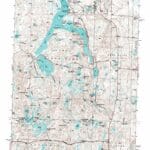Warrick County’s Geographic Information System (GIS) offers a wealth of data, waiting to be explored. Think of it as a digital treasure map, leading you to a deeper understanding of the county’s landscape, resources, and communities. This guide will illuminate the what, where, and why of Warrick County’s GIS data, empowering you to navigate this valuable resource effectively. Unlock the geographical secrets of Indiana with interactive maps and data through the Vermillion County Indiana GIS portal.
Exploring Warrick County’s GIS Data
Warrick County, Indiana, provides a powerful GIS platform, offering spatial data insights into the county’s makeup. This platform serves as a central hub for crucial information, ranging from property lines and zoning details to key environmental features and intricate infrastructure layouts. Explore detailed property information, zoning regulations, and environmental data with the comprehensive Warrick County GIS system.
What Data is Available?
Warrick County offers a robust collection of GIS data, accessible through various platforms. The primary portal, WTH GIS (https://warrickin.wthgis.com), provides a comprehensive and user-friendly experience. Here’s a glimpse of what you can find:
- Property Information: Property lines, parcel dimensions, tax assessments, and ownership history.
- Zoning & Land Use: Detailed zoning maps outlining permitted land uses in different areas.
- Infrastructure: Locations of utilities (underground pipes and cables), roads, and other vital infrastructure.
- Environmental Data: Information about local ecosystems, potential hazards, and natural resources.
- Elevation Data: Terrain elevation, crucial for flood planning, construction, and agricultural land use.
- Aerial Imagery: High-resolution aerial photos offering a bird’s-eye view of the county.
Beyond WTH GIS, supplementary resources enrich the data landscape:
- Warrick County Office (https://www.countyoffice.org/in-warrick-county-gis-maps): Focuses on tax information, property records, and aerial imagery, particularly useful for public land surveys and geospatial data.
- Warrick County Soil and Water Conservation Offices (https://www.gis-data.org/in-warrick-county): Provides GIS data on soil composition, water resources, including ground and surface water maps, vital for environmental studies and land management.
- IndianaMap (https://www.in.gov/gis/geoinsights/indianamap): Offers a statewide context, providing authoritative data and web services that can complement local data from Warrick County.
- XSoft Engage (https://engage.xsoftinc.com/warrick/Map): Specializes in property data, maps, and resources specifically tailored to Warrick County assessments, essential for property professionals.
- Acres GIS Maps (https://www.acres.com/plat-map/map/in/warrick): Offers detailed plat maps, property boundaries, ownership details, soil maps, elevation data, and other geographic features for a granular view of the county’s 40,103 parcels.
- NETR Online (https://map.netronline.com/indiana-warrick/18173): Provides tools for in-depth property research, including environmental concerns, historical aerial photographs, and other historical data layers, enhancing the understanding of land use change over time.
- Rockford Map Publishers (https://rockfordmap.com/maps/indiana-warrick-county): Offers precise parcel maps with detailed information on land ownership, property lines, parcel boundaries, acreage, latitude/longitude coordinates, and other relevant geographic features, supporting detailed land surveys and property management.
Accessing the GIS Platform
Accessing Warrick County’s GIS is remarkably easy. Simply visit the WTH GIS platform (https://warrickin.wthgis.com)—no specialized software is required. Its intuitive interface allows for multiple search methods:
| Search Method | Description |
|---|---|
| Address | Enter a street address to locate a specific property. |
| Intersection | Specify the intersection of two streets. |
| Parcel Number | Use the unique parcel identifier for precise location information. |
| Owner Name | Search for properties owned by a specific individual or organization. |
Utilizing Warrick County GIS Data
The true power of GIS lies in its practical applications. It transforms raw data into actionable insights, empowering various users:
Residents
- Property Research: Gain detailed knowledge about properties, including boundaries, tax assessments, and potential flood risks, informing buying/selling decisions.
- Project Planning: Locate utility lines and understand terrain slope for informed home renovations and landscaping projects.
- Neighborhood Insights: Explore zoning regulations, historical data, and local amenities to foster a deeper understanding of your community.
Businesses
- Site Selection: Analyze demographics, traffic patterns, and resource availability for optimal business location decisions.
- Market Analysis: Understand target market characteristics for effective marketing strategies.
- Infrastructure Planning: Access utility locations and elevation data for efficient project planning and expansion.
Government & Professionals
- Urban Planning & Development: Manage growth, plan infrastructure improvements, and make data-driven zoning decisions.
- Environmental Management: Analyze environmental data for resource protection, risk assessment, and sustainable planning.
- Emergency Response: Utilize accurate location information for efficient navigation and resource allocation during emergencies.
- Infrastructure Management: Track assets, assess conditions, and prioritize maintenance activities for roads, bridges, and other crucial infrastructure.
- Real Estate & Development: Evaluate development opportunities, assess site suitability, and provide clients with comprehensive property information.
- Researchers & Students: Explore local geography, history, demographics, and conduct spatial analysis for research and educational purposes.
The Future of Warrick County GIS
Warrick County’s GIS journey is an ongoing evolution. Future developments may include:
- Predictive Modeling: Anticipating development trends and informing proactive planning decisions.
- Enhanced Disaster Preparedness: Improving community safety and resilience through advanced geospatial analysis.
- Real-Time Data Integration: Incorporating live data feeds on traffic, weather, and other dynamic conditions for improved resource management.
- AI & Machine Learning: Unlocking deeper insights from geospatial data through advanced analytical techniques.
This guide provides a foundational understanding of Warrick County’s GIS resources. As the system evolves, ongoing exploration and learning will unlock even greater potential from this powerful tool. While striving for accuracy, remember that some data may have limitations or be subject to revisions. Always verify critical information through official channels.
- Revolution Space: Disruptive Ion Propulsion Transforming Satellites - April 24, 2025
- Race Through Space: Fun Family Game for Kids - April 24, 2025
- Unlocking the Universe: reading about stars 6th grade Guide - April 24, 2025
















